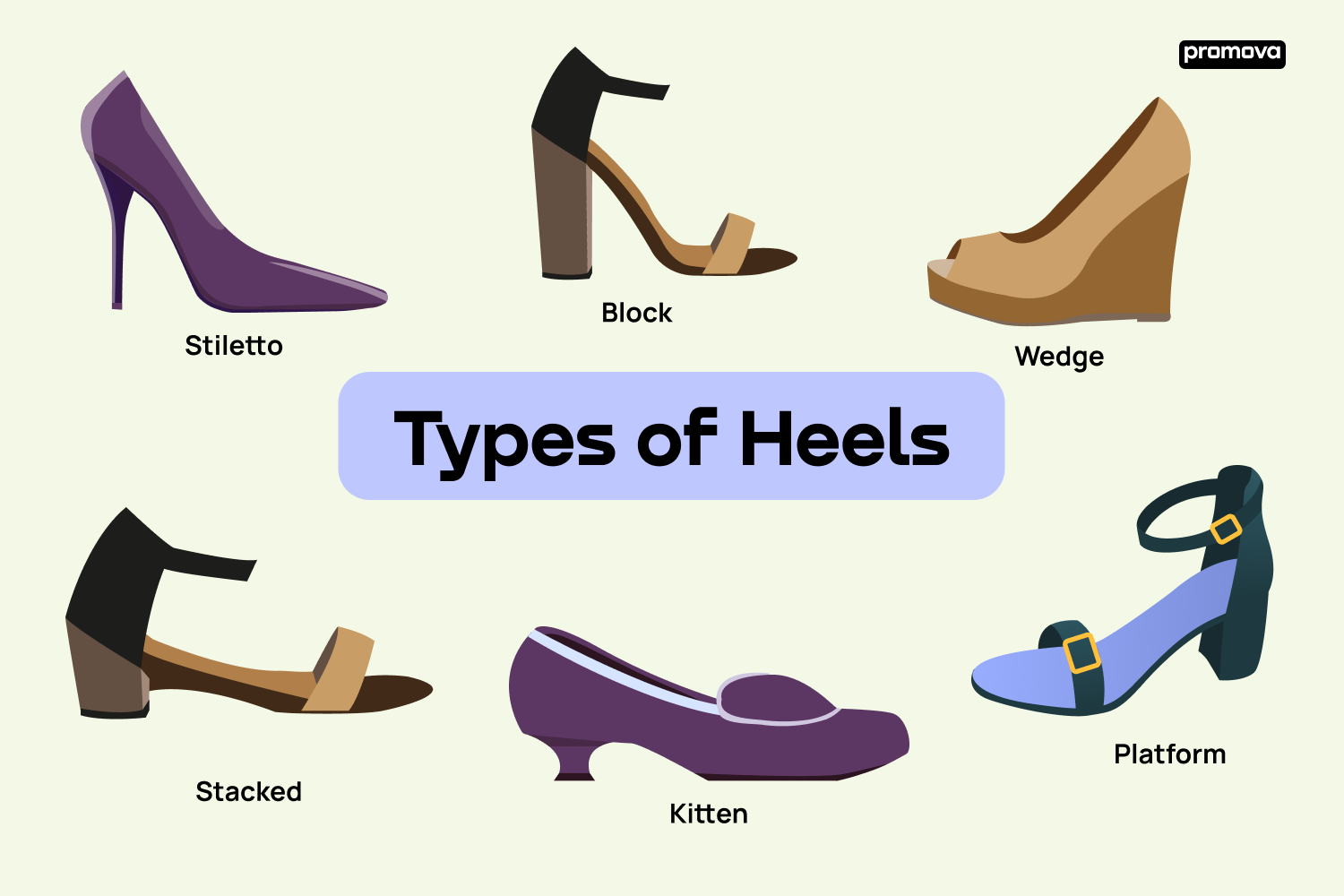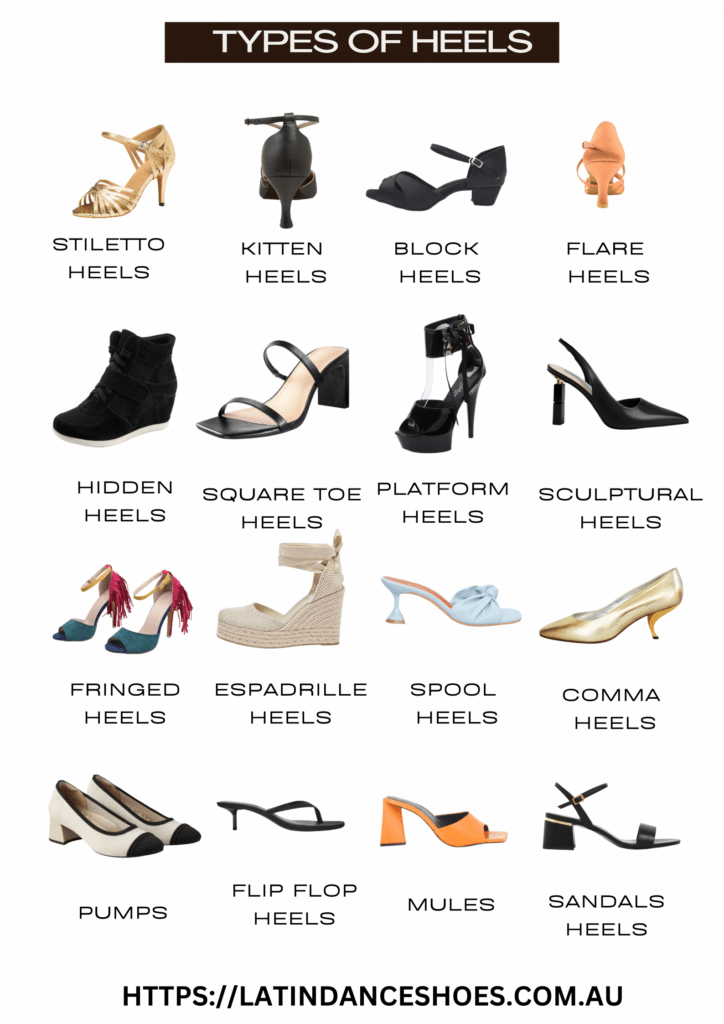Heels have long been a staple in women’s fashion, not only adding height but also elegance and sophistication to an outfit. Over the decades, various types of heels have emerged, each serving different purposes, styles, and comfort levels. In this comprehensive guide, we will explore the various types of heels, their characteristics, cultural significance, pros and cons, and tips for wearing them. Whether you’re preparing for a formal event, a casual outing, or everything in between, this article has you covered.
The Evolution of Heels
The history of heels dates back to the 10th century when Persian cavalrymen wore them to help keep their feet in stirrups. Today, heels have transformed into a fashion statement seen in various forms. Understanding this evolution helps appreciate the diverse types of heels available today.
Types of Heels
1. Stiletto Heels
Stiletto heels are synonymous with elegance. Typically 3-6 inches high, they have a long, slender heel that tapers to a point.

Pros:
- Enhances posture and elongates the legs.
- Versatile for various occasions.
Cons:
- Can be uncomfortable for prolonged wear.
- High risk of ankle injuries.

2. Kitten Heels
Kitten heels are a more comfortable alternative, usually around 1.5-2 inches high. They offer a slight lift without compromising comfort.
Pros:
- Good for all-day wear.
- Retains a stylish look.

Cons:
- Less dramatic than higher heels.
- Can sometimes lack support.
3. Block Heels
Block heels provide stability and comfort. Usually wider, they can range from 2-4 inches in height.

Pros:
- Provides better balance and comfort.
- Great for casual and formal wear.
Cons:
- May not always look as sleek as stilettos.
- Can be bulkier in appearance.

4. Wedge Heels
Wedge heels are an excellent option for those who want height without the discomfort of traditional heels. They feature a solid heel that extends from the back of the shoe to the toe.
Pros:
- Even distribution of weight.
- Comfortable for walking.

Cons:
- Less versatility in style.
- Can be challenging to balance on uneven surfaces.
5. Platform Heels
Platform heels have an additional layer of cushioning in the sole, making them more comfortable compared to other high heels.

Pros:
- Provides height while being easier on the feet.
- Variety of styles and designs available.
Cons:
- Can look bulky.
- Stability can be an issue for some designs.

6. Cone Heels
Cone heels are tapered at the bottom, resembling a cone shape. They offer a unique silhouette while providing moderate height.
Pros:
- Stylish and trendy.
- Offers a balance between stability and style.

Cons:
- Can be less robust than block heels.
- May not be suited for all occasions.
7. Cuban Heels
Originating from Western styles, Cuban heels are short, broad, and slightly flared, often found in men’s and women’s boots.
Pros:
- Comfortable for dancing or prolonged standing.
- Easy to pair with a variety of outfits.
Cons:
- Less formal and elegant compared to other heels.
- Limited height increase.
Comparison Table of Types of Heels
| Type of Heel | Height | Comfort Level | Occasions | Pros | Cons |
|---|---|---|---|---|---|
| Stiletto | 3-6 inches | Low | Formal | Elegant, posture-enhancing | Uncomfortable, injury risk |
| Kitten | 1.5-2 inches | High | Casual, Semi-Formal | Stylish, good for all-day wear | Less dramatic |
| Block | 2-4 inches | High | Casual, Office | Stable, fashionable | Bulkier appearance |
| Wedge | 2-4 inches | High | Casual | Comfortable, stable | Less versatile |
| Platform | 3-5 inches | Medium | Casual, Party | Height with comfort | Can look bulky |
| Cone | 2-4 inches | Medium | Casual, Semi-Formal | Trendy, balanced style | Less robust |
| Cuban | 1.5-2.5 inches | High | Casual, Dance | Comfortable, versatile | Limited height |
Wearing Heels: Tips for Comfort and Style
Choosing the right heel is just the beginning. Here are some practical tips for ensuring comfort and style while wearing heels:
1. Choose the Right Size
Proper fit is crucial. Always try on heels at the end of the day when your feet are slightly swollen. Ensure there’s enough room in the toe box without feeling cramped.
2. Opt for Cushioned Insoles
Insoles can provide additional comfort and support. Look for gel or padded insoles specifically designed for high heels.
3. Break Them In
Before wearing new heels for an event, wear them around the house to break them in gradually. This can prevent blisters and discomfort.
4. Take Breaks
If you’re at an event, find moments to sit down and rest your feet. This is particularly important during long gatherings or parties.
5. Practice Walking
Walking in heels requires practice. Start by walking on flat surfaces before trying uneven ground. Consider practicing on various terrains to improve your balance.
Local Experiences: Heels in American Culture
Heels hold a significant place in American fashion culture, representing a blend of empowerment and elegance. From the iconic stiletto of the 1950s to the resurgence of block heels in the 2020s, each era has its take on what heels symbolize. Fashion shows in major cities like New York often highlight innovative designs and reimagine traditional styles, making the runway a crucial platform for showcasing new trends.
Conclusion
Understanding the various types of heels on shoes can empower your fashion choices and enhance your confidence. The right pair of heels can elevate not just your height but your overall presence, allowing you to express your unique style. Whether you prefer the classic elegance of stilettos or the comfort of block heels, there’s a perfect pair for every occasion. Embrace the art of wearing heels and enjoy the confidence they bring!
Frequently Asked Questions (FAQs)
1. What is the most comfortable type of heel?
Block heels and kitten heels are generally considered the most comfortable due to their stability and lower height.
2. How do I choose the right heel height?
Consider your comfort level, the occasion, and how long you’ll be wearing them. If you’re new to heels, starting with lower heights is advisable.
3. Can I wear heels with jeans?
Absolutely! Heels can elevate the look of casual outfits, including jeans. Pair block or wedge heels for a chic casual look.
4. Are there any heel types that are considered out of style?
Fashion is always evolving, but classic styles like stilettos and block heels tend to remain popular. Wedge heels fluctuate in popularity based on seasonal trends.
5. What materials are best for heels?
Leather and suede are popular materials for heels due to their durability and comfort, while synthetic materials can be more affordable and offer unique styles.